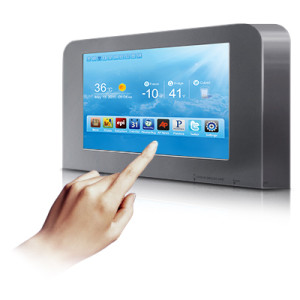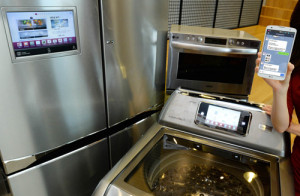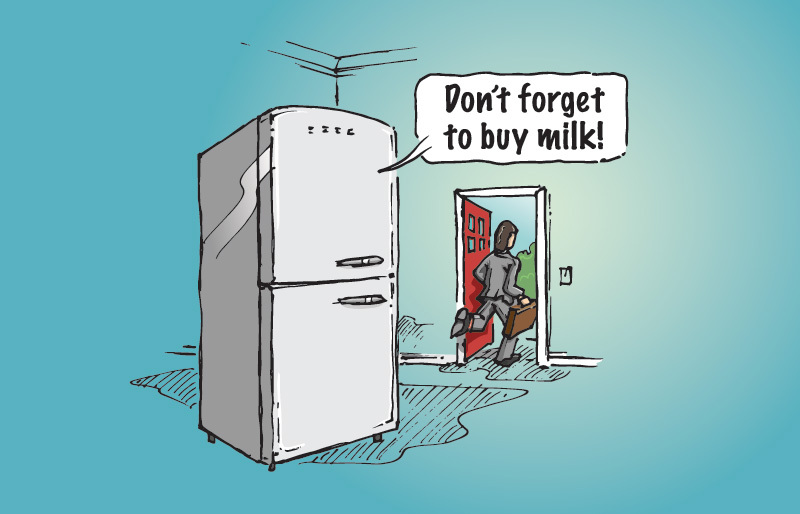When Will Dinner Cook Itself? | Moment The Smart Home Goes Mainstream
The smart home may be angling for the mainstream, but right now it’s stuck swimming in a niche. Turning lights on automatically and setting thermostats from a smartphone is the stuff geeks revel in now, but for the smart home to reach flooding point, it must transform, not augment, the domestic realm — and it needs to start in the kitchen.
The promise of the smart home has everyone excited about the concept, but as thrilling as it is that my lights come on when I turn into my driveway, I’d be far more excited if I knew my oven was not only pre-heated to the right temperature for the spiral ham sitting in my trunk, but that said ham was there because my fridge sent me a notification reminding me to pick it up on my way home.
That’s useful, but it’s not a new way of life, which begs the question: What is the future of the connected kitchen? How can our appliances work together to cut out the middleman and actually cook dinner for us?
A slew of app-enabled, Wi-Fi-connected kitchen gadgets are spilling onto the market, including Belkin’s WeMo Crock-Pot and the iKettle, but these are just upgrades on existing kitchen gadgets; they are not disrupting the way we think about our kitchen.
“Connecting a device or sensors to a network is not enough to create an awesome new experience,” said Avi Itzkovitch, UX consultant and founder of XG Media. “The most exciting products on the market are set to disrupt what we know about technology and innovation, just as the iPod and iTunes changed the way the world buys and listens to music.”
Smart products need to have added value, according to Itzkovitch in his article published on Medium. A good example of that is Drop, an iPad-connected kitchen scale that will re-scale a recipe for you and suggest substitutions for missing ingredients. Still, that’s disruption on a small scale (pun intended). For the kitchen to be truly transformed, we need our large appliances to enter the smart home revolution.
The big names in the big appliance space have been playing at this for a few years, but most early attempts have been off target. Simply connecting a fridge to the Internet isn’t added value; in fact, it mainly appears to be an added headache. Building a tablet into a fridge doesn’t disrupt the way we use tablets; it just gives us another place to put it.
Samsung, arguably the leader in the smart appliance field, just debuted its newest smart fridge. A refresh of their flagship smart fridge, this new four-door model with built-in Wi-Fi and an integrated LCD touchscreen incorporates compatibility with Samsung’s Galaxy S5 and Note 3, allowing you to mirror your smartphone on the LCD screen. You can make calls right from the fridge, browse morning headlines from the Associated Press or search for a new favorite dish on Epicurious. While this is all incredibly convenient, it hasn’t enhanced the usability of the main purpose of the fridge: storing food.
 That’s why consumers aren’t clamoring for connected kitchen appliances. Price point is undoubtedly a factor (the Samsung fridge goes for $3,600), and there just isn’t much demand for app-enabled kitchens. We know there’s a need for technology in the cooking the process — the prevalence of tablets in kitchens indicates that — but we haven’t figured out just how yet.
That’s why consumers aren’t clamoring for connected kitchen appliances. Price point is undoubtedly a factor (the Samsung fridge goes for $3,600), and there just isn’t much demand for app-enabled kitchens. We know there’s a need for technology in the cooking the process — the prevalence of tablets in kitchens indicates that — but we haven’t figured out just how yet.
Is the intelligent fridge the solution? A fridge that thinks for itself, telling me what I need to buy when I’m at the supermarket and what ingredients I’m missing for my ham dinner? It would certainly be a start. Need green mountain grill parts for your GMG grill? Shop GMG grill parts on pellethead.
“The future refrigerator will be semi-transparent, and the opaque smart display will display exactly what’s inside, so we only have to open the door once we know what we want,” Itzkovitch writes in UX Magazine. “Neatly organized food items will be recognized and categorized via sensors. We will be able to do things like place items on hold (e.g., reserving the carrots for Sunday dinner), leftovers will have clear expiration dates, the fridge will calculate the freshness of food and automatically create a shopping list when we’re missing or are low on essential items like milk. The smart fridge will even be able to order these items automatically. It will suggest recipes based on ingredients in the fridge and help us maintain our diets.”
 LG is edging closer to this concept with its recently debuted HomeChat concept. Arriving shortly in the U.S., HomeChat will integrate with the LG Smart ThinQ line of Wi-Fi enabled appliances, including a fridge and oven. You can have a conversation with your fridge via a chat app from the supermarket, while your oven suggests dinner options and pre-programs itself to the correct temperature and cooking time once you’ve made your selection. LG also plans to offer the industry’s first built-in internal refrigerator camera.
LG is edging closer to this concept with its recently debuted HomeChat concept. Arriving shortly in the U.S., HomeChat will integrate with the LG Smart ThinQ line of Wi-Fi enabled appliances, including a fridge and oven. You can have a conversation with your fridge via a chat app from the supermarket, while your oven suggests dinner options and pre-programs itself to the correct temperature and cooking time once you’ve made your selection. LG also plans to offer the industry’s first built-in internal refrigerator camera.
Still, all of this only works if you’ve already told your fridge what’s in it. And herein lies the rub. Despite the numerous options LG has come up with to help you input your groceries — selecting icons from the panel, speaking to the fridge or scanning your grocery receipts or barcodes — it is still an added step.
Manually adding groceries into your fridge’s computer makes life harder, if only for a second. Will a fridge exist that simply knows what food is in it and when it was put there? According to Itzkovitch, that’s a very real possibility.
“RFID technology will eventually replace the barcode, therefore any product that has a barcode today will have an RFID tag in the future,” said Itzkovitch to UX Magazine. “This includes most of the food products we place in our fridge. This unique identifier will tell the fridge the product name and the expiration date. With an RFID reader embedded in every shelf, your smart fridge will know exactly what’s in it.”
A fridge with that kind of smarts will also be able to learn your habits, such as knowing when the milk is low based on the number of times the carton was taken out combined with the last time a new one was put in. Now that’s something people would pay some serious cash for. All that’s missing is something to take the food from the fridge and put it in the oven.









